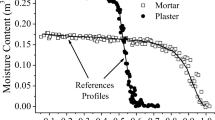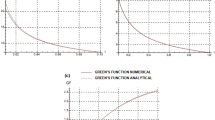Abstract
This paper deals with a new governing equation for anomalous diffusion encompassing a large spectrum of phenomena with particular attention on delaying processes. The analysis starts with a discrete approach and a law of evolution introducing a partial retention of the diffusing particles at each time step. The resulting differential equation assuming that the concentration function belongs to class C3 is a fourth-order differential equation. To fit this result into the framework of a new theory, a bi-modal flux distribution for the diffusion process associated with two energy states is proposed. The first energy state is related to the set of particles flowing according to the Fick’s law and the complementary set follows a new law. Two key parameters are introduced, namely, a parameter β indicating the fraction of the particles in the principal energy state and a parameter R controlling the effect of the secondary flux. Some examples are presented characterizing different types of phenomena as function of the relative values of β and R. The necessary conditions for the retention behavior are discussed for some particular cases.







Similar content being viewed by others
References
Islam MA (2004) Einstein-Smulochowski diffusion equation: a discussion. Phys Scripta 70((2–3)):120–125
Philibert J (2006) One and half century of diffusion: Fick, Einstein, before and beyond, diffusion-fundamentals.org. 4 6.1–6.19
Brandani S, Jama M, Ruthven D (2000) Diffusion, self-diffusion and counter-diffusion of benzene and p-xylene in silicalite. Microporous Mesopor Mat 35–36:283–300
Crank J, Henry ME (1949) Diffusion in media with variable properties. Part I. The effect of a variable diffusion coefficient on the rates of absorption and desorption. Trans Faraday Soc 45:636–650
Crank J, Henry ME (1949) Diffusion in media with variable properties. Part II. The effect of a variable diffusion coefficient on the concentration-distance relationship in the non-steady state. Trans Faraday Soc 45:1119–1130
Hall LD (1953) An analytical method of calculating diffusion coefficients. J Chem Phys 21(1):87–89
Küntz M, Lavallée P (2004) Anomalous diffusion is the rule in concentration-dependent diffusion processes. J Phys D Appl Phys 37(1):L5–L8
Vanaparthy SH, Barthe C, Meiburg E (2006) Density-driven instabilities in capillary tubes: influence of a variable diffusion coefficient, Phys. Fluids 18 (n.4): 048101-1
Atsumi H (2002) Hydrogen bulk retention in graphite and kinetics of diffusion. J Nucl Mater 307–311:1466–1470
Atsumi H, Tanabe T, Shikama T (2011) Hydrogen behavior in carbon and graphite before and after neutron irradiation—trapping, diffusion and the simulation of bulk retention. J Nucl Mater 417:633–636
D`Angelo MV, Fontana E, Chertcoff R, Rosen M (2003) Retention phenomena in non-Newtonian fluids flow. Physics A 327:44–48
Deleersnijder E, Beckers J-M, Delhez EJM (2006) The residence time of setting in the surface mixed layer. Environ Fluid Mech 6:25–42
Huang J-C, Madey R (1982) Effect of liquid-phase diffusion resistance on retention time in gas-liquid chromatography. Anal Chem 54(2):326–328
Kindler K, Khalili A, Stocker R (2010) Diffusion-limited retention of porous particles at density interfaces. Proc Natl Acad Sci USA 107:22163–22168
Ferreira JA, Branco JR, Silva P (2010) Non-Fickian delay reaction–diffusion equations: theoretical and numerical study. Appl Numer Math 60(5):531–549
Fort J, Méndez V (2002) Wavefronts in time-delayed reaction-diffusion systems. Theory and comparison to experiment. Rep Prog Phys 65:895–954
Jianhong W, Xingfu Z (2001) Traveling waves fronts of reaction-diffusion systems with delay. J Dyn Differ Equ 13(3):651–686
Sen S, Ghosh P, Riaz SS, Ray DS (2009) Time-delay-induced instabilities in reaction-diffusion system. Phys Rev E 80:046212
Zanette TH (1999) Statistical-thermodynamical foundations of anomalous diffusion. Braz J Phys 29(1):108–124
Cohen DS, Murray JM (1981) A generalized model for growth and dispersal in a population. J Math Biol 12:237–249
Kurzynski M, Palacz K, Chełminiak P (1998) Time course of reactions controlled and gated by intramolecular dynamics of proteins: Predictions of the model of random walk on fractal lattices. Proc Natl Acad Sci USA 95((n. 20)):11685–11690 Biophysics
Mainardi F (1996) The fundamental solutions for fractional diffusive-wave equation. Appl Math Lett 9((n. 6)):23–28
Scherer R, Kalla SL, Boyadjiev L, Al-Saqabi B (2008) Numerical treatment of fractional heat equations. Appl Numer Math 58(8):1212–1223
Bevilacqua L, Galeão ACNR, Costa FP (2011) On the significance of higher order terms in diffusion processes. J Braz Soc Mech Sci 34(2):166–175
Bevilacqua L, Galeão ACNR, Costa FP (2011) A new analytical formulation of retention effects on particle diffusion processes. An Acad Bras Cienc 83(4):1443–1464
Osborne WA, Jackson LC (1914) Counter diffusion in aqueous solution. Biochem J 8(3):246–249
Schaefer KE (1974) Present status of underwater medicine. Review of some challenging problems. Cell Mol Life Sci 30(3):217–221
Broadbridge P (2008) Entropy diagnostics for fourth order partial differential equations in conservation form. Entropy 10:365–379
Simas (2012) Resolução Numérica para o Problema de Difusão com Retenção. MSc Thesis, LNCC/MCT
Acknowledgments
The results presented in this paper could not be achieved without the support of the National Research Council (CNPq) through the Research Fellowship Program, and the Research Project : 480865/2009-4. We are also indebted with the State of Rio de Janeiro Foundation, Research project: E-26/101.728/2010, for the scholarship granted to one of the authors of this paper.
Author information
Authors and Affiliations
Corresponding author
Additional information
Technical Editor: Fernando Alves Rochinha.
Rights and permissions
About this article
Cite this article
Bevilacqua, L., Galeão, A.C.N.R., Simas, J.G. et al. A new theory for anomalous diffusion with a bimodal flux distribution. J Braz. Soc. Mech. Sci. Eng. 35, 431–440 (2013). https://doi.org/10.1007/s40430-013-0041-y
Received:
Accepted:
Published:
Issue Date:
DOI: https://doi.org/10.1007/s40430-013-0041-y




